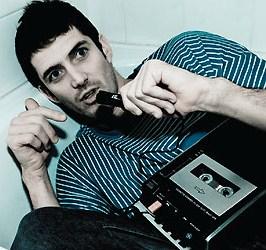Choreographer Stephanie Lake has created an impressive, poundingly vital elegy to the vicissitudes of love in her first full length dance work Mix Tape currently in premier performance at Melbourne’s Chunky Move Studio.
Although this is her first major work, Lake is well known to dance audiences through her prior success as a dancer with Lucy Guerin, BallletLab and Chunky Move, and more recently, as a teacher at VCA.
Love and Dance were made for each other but choosing Love as the generative theme for her work was a risky move. In this era love is mass-media content fodder and it can too easily read as hackneyed or clichéd. A work structured around love might risk becoming overtly narrative. All the more risky because, Lake structured her work as sequence of vignettes each taking their point of departure from favourite love song and vocal extracts from interviews.
That might have been a problem in itself was it not for her almost brutal honesty. It’s sometime very humorous, and always aesthetically beautiful to watch, but what Lake has achieved is a dance interpretation of contemporary love as it exists in life – love that elides with physical intimacy, love that defines social status and position, love that damages and hurts – and it gives her work a stinging authenticity.
The dance unfolds against a simple set, a bookcase nostalgically filled with cassettes, an old reel-to-reel recorder and a vinyl disk record player. Coloured swing arm lights bring these into focus from time to time as if Lakes’ own study was brought to life and talking to us. Simple muted floods at the wings and overhead cast sculptural shadows across the dancer’s bodies. The costuming, simple and refined, by Harriet Oxley, ranges from ultra-baggy pants to red-black striped all in one swim-wear (vaguely evocative of Death in Venice), all subtlety and perfectly balanced with the dance.
In each scene a short fragment of recorded interview and music set the theme. From the opening the dancers thumped, almost tap-dancing in bare-feet, the rhythm of the music and when later they also speak, murmur, sing and strum ukuleles, we know they are embodiments of the music-voice metatext.
And the dancing is superb both in its technical excellence and in the palpable artistic connection each of the performers expressed for the work in their manifold nuances. Although realised from a female perspective there is an uncanny sympathy for the desolation of the male. An important scene has Rennie McDougall and Timothy Ohl acting out a boyish and aggressive counterpoint to a more subtly and humorously expressed memory recounted by a woman.
The male dancing is particular strong in this work, and at times the dance is brutal with a female body being hurled in an almost violent way between the male dancers. McDougall caught a lot of attention recently when he stepped in as the understudy to an injured Luke George in Now, Now Now and he, as well as the more experience Ohl, are dancers whose strength, technique and personalities make their dance compelling to watch.
There are moments of ingenious beauty, in particular the sequence where the dancers meld, dressed in baggy clothes, as they mumble as if in a sleep state, while their bodies coalesce, then tumble over each other in elegantly descending cascades. Then limbs and heads are made to penetrate the costume openings of another dancer, at the neck, the arm, the waist, in a metaphor of a sort of desperate intimacy.
There is no sentimentality in the work. Gestures are patterned and stereotyped, often mirrored in near perfect symmetry so that when asymmetries are introduced they evoke the way we imperfectly mimic the language of love and affection, with varying success, from other.
There are kisses but they are mechanical. Where the dancers connect most intimately in is tender and tentative touches of their fingers, and when these are overtly shadowed against a brown paper backdrop the effect is one of utter fragility. There is an undertone of existential isolation.
As the work draws to an end, Ohl clad in underpants only, arches out a convulsed and pained sequence entirely on the floor. It’s an agony, a spasm of tortured soul. The work concludes with Ohl, and then McDougall on the floor, limp, almost moribund. The women enter and place bowls of tea-light candles on the floor illuminating their faces. Darkness envelopes as the candles are snuffed out with a last breath. That scene at first seemed to recall Dylan Thomas exhortation to rage against the dying of the light- an emblem of how love sustains as much as it damages us.
But as the darkness persisted I thought more of WH Auden’s idea that death is not the end of life but the end of love. Were it not for art – and here the dance is art – these truths could be too painful to endure.
WORLD PREMIERE: Mix Tape by Chunky Move. 2-11 September 2010 at Chunky Move Studios Melbourne, Australia. Direction and choreography, Stephanie Lake. Lighting Design, Benjamin Cisterne – Bluebottle. Sound Design, Luke Smiles – motion laboratories. Costume Design, Harriet Oxley. Performers: Sara Black, Rennie McDougall , Timothy Ohl , Jorijn Vriesendorp.





